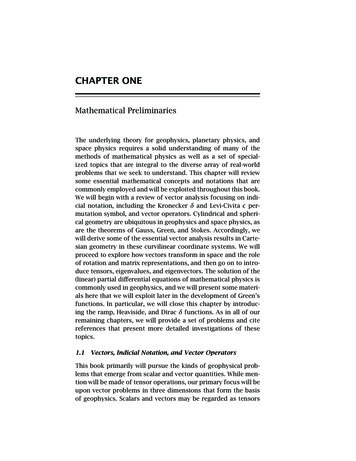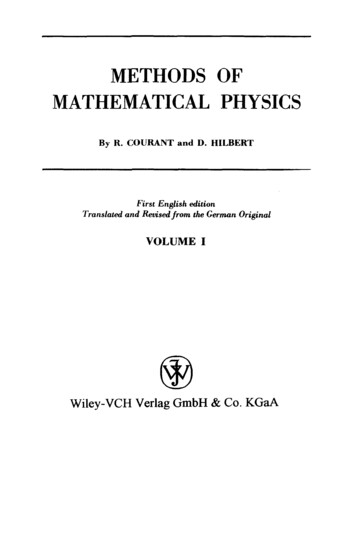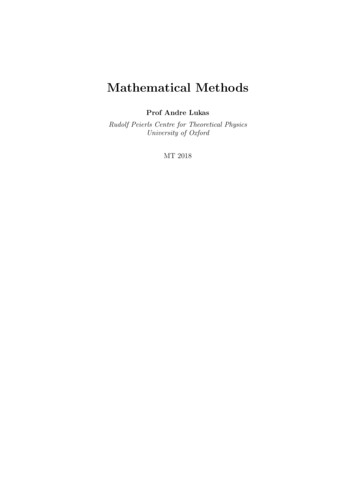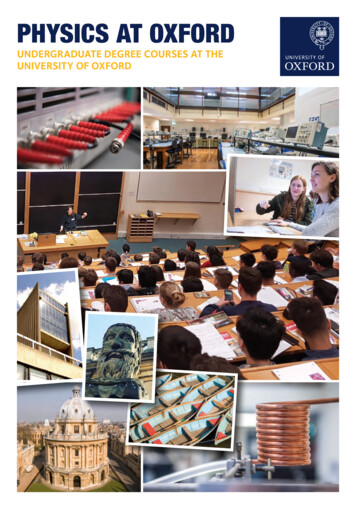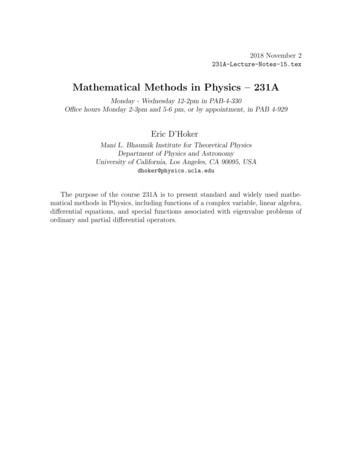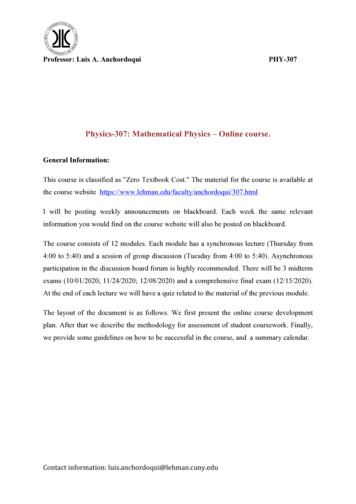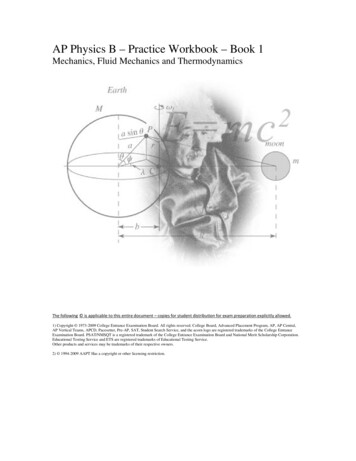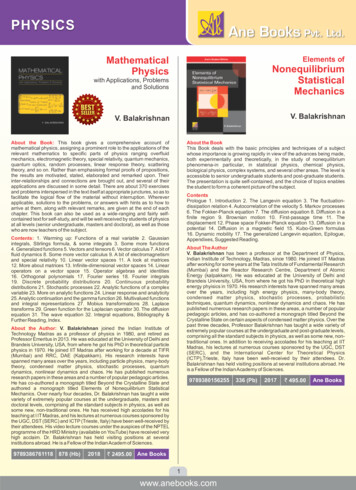
Transcription
Mathematical Physics Problems:Thesaurus and OntologyOlga Ataeva1, Vladimir Serebryakov1, Natalia Tuchkova11Dorodnicyn Computing Centre, Federal Research Centre “Computer Science andControl” of the Russian Academy of Sciences, 40 Vavilov St., MoscowAbstract. The work is devoted to the study of knowledge representation in thesubject area “Equations of mixed type in the sections of mathematical physics”.Such comprehensive resources as Wikipedia, claim to be encyclopedicknowledge, but cannot provide informational support for in-depth research. Thisis a field of activity for specialists in specific areas of knowledge.The thesaurus and ontology are considered as a formal means of describing thesubject area. This approach takes into account the peculiarities of knowledge representation in the domain, namely the presence and use of formulas as independent objects. Consideration of the domain features leads to a reduction in searchnoise and a reduction in search time within the framework of the constructedlibrary. The use of thesaurus and ontology in the design of a digital semanticlibrary is considered.Keywords: mathematical physics, thesaurus, ontology, formulas and texts, digital libraries1IntroductionThe issues with information representation of mathematical knowledge in digital spaceare directly related to the logical framework organization set within the mathematicalsubject domains. The research is prompted by spreading digital information representation in mathematical sciences and explained by the effect mathematics now have onthe developed countries’ economy [1]. Many papers highlight that the way mathematical branches are presented on the Internet is significant, for the future of science ingeneral as well [2]. The analysis of digital mathematical resources shows that it is essential to generate relevant thesauri to build digital information images of mathematicalsubject domains relying on scientific knowledge ontologies. Such comprehensive resources as Wikipedia, Wiktionary claim to be encyclopedic knowledge, but cannot provide informational support for in-depth research. This is a field of activity for specialistsin specific areas of knowledge.They do not reveal the essence and mathematical meanings of concepts, in contrastto a special tool – the thesaurus of the subject area, where emphasis is placed on semantics and the use of the term in linked publications. The originality of the proposedCopyright 2019 for this paper by its authors. Use permitted under CreativeCommons License Attribution 4.0 International (CC BY 4.0).158
work is that the bibliographic base is associated with persons, and there is an opportunity for authors and experts to replenish information by linking it to existing termsand complement the list of terms, including in Russian.The main condition for research information support is the provision of up-to-dateinformation on achievements, confirmed by publications of professionals. Naturally,the mathematical resources on the Internet need such professional information support.Known databases of scientometric data of publishing houses partially perform thisfunction in the section of actual publications. However, exponentially growing numberof publications, it complicates the search, requires expensive and time consuming. Inthis case, every professional is interested in having a collection on a certain topic. It ispossible to organize the creation of such a collection technologically by using thematicthesauri and the mechanism of their replenishment, as proposed in this paper. Featureof modern digital representation of the data makes it possible to move the centuriescreated thesauri and ontologies in thematic databases and thereby ensure their searchfor the completion and updating.Another feature of mathematical subject domains is explained by the fact that mathematical statements in natural language are better expressed as mathematical equations.When building information images for branches of mathematical physics it is crucial toconsider the listed aspects, specifically, rely on representative dictionaries which defineterms and formulas as a background for information retrieval thesaurus for the subjectdomain.In [12], a thesaurus was presented for the subject domain “ordinary differential equations” and now its extension to the domain of “partial differential equations” is beingdeveloped as part of a common mathematical resource on “equations of mathematicalphysics”. Numerous studies of specialists, such as V. A. Steklov [13], V. S. Vladimirov[14], R. Curant, D. Gilbert [15], A. N. Tihonov, A. A. Samarsky [19], A. G. Sveshnikov, A. N. Bogolyubov [20], M. M. Smirnov [16], A. V. Bitsadze [17], V. A. Ilyin,E. I. Moiseev [18] and other classics of mathematical analysis and differential calculusallow to establish paradigmatic connections of concepts and formulas to use them aslexico-semantic data arrays for presentation and search in mathematical informationresources.This paper describes the creation of the ontological model of a thesaurus for someproblems of mathematical physics within the framework of the terminology of the semantic library LibMeta and its use in the tasks of searching and navigating through itsresources. At the first stage, a series of related dictionaries for individual equations iscombined into a thesaurus. It is incomplete and therefore a means is proposed for replenishing it with the inheritance of previous knowledge from available data from opensources. It turns out a non-standard resource, but it reflects the state of modern research.2Thesaurus DescriptionMathematical physics deals with mathematical models of physical phenomena [3]. Itrelies on mathematical methods to build and study the models [3–5]. The methods ofmathematical modelling enable us to solve mathematical problems applying equations159
of differential calculus [3], [4]. Each equation establishes a correlation between mathematical model and physical phenomena. The topics to be described are as follows:problems of mathematical physics, modeling methods, equations, methods of solutions,solutions and their analysis.The thesaurus was formed by analyzing the original works of classics of mathematical analysis and differential calculus, and a representative list of articles was organizedfor that purpose. The problem of defining paradigmatic relations between definitionsof certain fields in mathematical physics is brought to attention along with outlining thehierarchical relations between the terms that can be used when searching on the mathematical resources along with additional classification parameters set in secondary documents.It is possible to study a streamlined scheme (Fig. 1) to offer a step-by-step description to problems of mathematical physics starting with the name of physical/technicalprocess and ending with solutions to develop data layout in this domain.Fig. 1. The relation scheme in mathematical physics subject domainGiven that equations of mathematical physics, as a subject domain, cover a hugeamount of research, the paper focuses on physical processes identification, as the pillarof mathematical models, and partial differential equations terminology with examplesof mixed type equations.2.1 MPh ProblemsWhen describing the mathematical set of MPh problems, we consider it a hierarchy asprovided in Fig. 2 that follow the logic of the domain. The graphical representation isone of the ways to describe hierarchical relation of problems in mathematical physics[6].Fig. 2. The MPh problems relation scheme160
Such structure provides a topic-related distribution within the section describing theproblems of the MPh.2.2Partial Differential EquationLet us note the features related to partial differential equations that should be added tothe thesaurus: equation scope, as well as the material object of the physical process;summary on equation properties;researchers’ surnames, authorship, named equations;specific and associative equation formulas;synonyms for the terms.In different domains mixed type equations can be classified as hyperbolic, parabolicand elliptic [7]. Fig. 3 graphically shows hierarchical links of second order PDE withtwo independent variables.Fig. 3. Graphic chart representing linear/linear rather higher derivatives second order PDE withtwo independent variables161
2.3Thesaurus StructureWhile developing the thesaurus one of the main objectives is to develop its structureconsidering the characteristics of the domain. The structure consists of thematic sections, sets of links between the elements of the thesaurus, the structure of the thesaurusarticles.Thus, the basic version of the thesaurus includes the following main thematic sections: problems of mathematical physics equations of mathematical physics, partial differential equations, equations of mixed type.The analysis of the domain/subject area revealed the need to allocate the followingcategories for mentioned sections: Type of problem (elliptic, hyperbolic, parabolic); Dimension of the problem (one-dimensional, two-dimensional, three-dimensional); Type of equations (named, nominal); Homogeneity of equations (linear uniform, linear non-uniform, ); Types of equation coefficients (with variable coefficients, with constant coefficients, ); Types of equations (elliptic, hyperbolic, parabolic).Based on these categories, the following link are established: Task type – task dimension; Type of equations – type of equations; Uniformity of equations – types of coefficients in equations.The following thesaurus terms are also reflected: Hierarchical: genus, species; Horizontal: synonyms, associations.In addition to the main term categories in the thesaurus, it is necessary to introduceadditional categories that support generation of various links tied to objects that are notexplicitly reflected in the thesaurus but are necessary for the completeness of description. Such objects include Authors and References. In order to implement these features, thesaurus conceptual structure provides relevant set of links to describe references, authors, etc. References – introduced to describe references to literature that contains in-depthinformation about a concept of the thesaurus; Author – introduced for designating the author and the author's term for a concept.The mentioned hierarchically and horizontally linked categories form a conceptualmodel of the domain.The conceptual model of the thesaurus is thus reflecting the following: means to define concepts; method for defining concept synonyms; a list of conceptual properties and attributes;162
object category; composition of objects of each category.Thus, structurally, the concept of the thesaurus includes the following elements: alphanumeric code of the concept; concept descriptor; non-descriptor – concepts’ synonyms; thematic section of the concept; symbolic representation of the concept formula; list of links to other concepts; text additions (comments, notes, help); a list of references for the concept; authors of the concept.Given the essence of the structural description there is a need to include variouslexico-semantic categories as follows: type of equation: one-dimensional, two-dimensional, three-dimensional; type of equation: hyperbolic, parabolic, elliptic; types of coefficients: variables, constants; etc.Thesaurus Ontological ModelBasics of LibMeta Information ModelThe paper develops the resource for the topic in math on “mathematical physics problems”, index of “MPh mixed type equations” and its integration in LibMeta [8].LibMeta is an information system that implements a set of features that are necessaryto work with the content of a prospective semantic library. LibMeta is a special electronic library management system (ELMS). LibMeta library is a storage of structuredand diverse data with the ability to integrate it with other data sources that meet therequirements for sources within Linked Open Data [21]. Also the possibility of specifying its content by defining the subject area is presented.The versatility of the system’s content is based on the set of concepts which represents the LibMeta informational content model: information resource and informationobject that define a resource instance. The information resource is the basic descriptiveunit of library content, and the information object represents instance of informationresources. Each of them has its own unique LOD identifier. In fact, the semantic meaning of the information resource is equivalent to the concept of ontology class with discrepancies in description. The structure of the description of information objects is determined by the concepts of an attribute and a set of attributes that are defined in thedescription of the corresponding resource. The attribute is an element of a resourceproperty description, and the set of attributes is defined as a collection of different attributes. Attribute types are as follows: file, object, numeric, text, string.The model of the thesaurus at full compliance with ISO 25964 [9]. The model described by this standard supports multilingual thesauri and other types of dictionaries.163
The standard contains recommendations for establishing and maintaining mutual correspondence between several thesauri or between thesauruses and other types of dictionaries used in information retrieval. This standard is also compatible with the SKOSmodel, which offers a way to present thesauri in the Internet.The standard suggest rationale for using the following concepts: hierarchical relationship, horizontal relationship, term, thesaurus, concept, thematic group, terms, descriptor (or preferred term for a concept), non-descriptor (a set of terms that are synonymous with a descriptor). Earlier in [10] we provide analysis of the basic entities of theontology of the model, which forms the base of the ontological thesaurus model [10],presented in current publication.The base model of thesaurus is designed such way that the concepts of this thesaurusare related to the concept of an information object from the LibMeta content descriptionmodel and allow for concept association with any type of resource present in the library.Description of the ontological content model of the library allows you to describe additional types of resources like Authors and References and link them with the thesaurusto support them.2.4Basic Thesaurus Model ExpansionIn order to add the basic thesaurus version description [10], namely the structure of thethesaurus concepts, the system supports a class hierarchy for additional concept attributes. It includes subclasses of the ResourceAttribute superclass that add the descriptionof the concept structure that corresponds to a certain thesaurus with the following concept values: ThesaurusAttributeText – presented as a text; ThesaurusAttributeTaxonomy – presented in the form of item of a particular classifier or dictionary; ThesaurusAttributeString – presented as a string; ThesaurusAttributeObject – presented as a certain content library informationobject; ThesaurusAttributeNumber –presented as a number; ThesaurusAttributeHref – presented as a link; ThesaurusAttributeFile – presented as a file; ThesaurusAttributeConcept – presented as other thesaurus concepts (it definesrelationships between concepts implicitly supported in the system).Each of these classes is compliant with OWL-supported inheritance paradigm, thatcontains the properties ascribed to the ThesaurusAttribute superclass.The ThesaurusAttributeSet class contains the thesaurusAttributes property, which inturn contains many instances of the above listed classes that define the Concept classstructure of a thesaurus.The Thesaurus class is linked to ThesaurusAttributeSet through properties mediatorthesaurusAttributeSet.Such standardized modeling allows LibMeta to easily adjust the system to any subject area.164
The description of the thesaurus “The MPh Mixed Type Problems” based on initialontology version can be broadened by terms of an extended model, in order to furtherextend the article structure of this thesaurus, provided the following attributes areadded: 2.5comment;note;help;references;authors.Three Levels of Thesaurus ModelThe Comment and Note attributes represent ThesaurusAttributeText class attributes,with Help being ThesaurusAttributeString class attribute, while References and Authors are instances of the ThesaurusAttributeObject class. Combined they are a setof thesaurus attributes.Next, we analyze a three-level representation of the subject area thesaurus within theLibMeta library.In order to be able to use the thesaurus of a specific subject area, the following sequence should be followed when constructing a semantic library within LibMeta system.1. Based on the introduced model, a set of information resources used in the library is given. It is necessary to provide descriptions of the content of the futurelibrary in terms of the proposed model.2. The structure of the thesaurus is finally set up. On the basis of certain classesthe respective links between terms are set, the term description is expanded ifnecessary, the links with the system resources are determined as well.3. According to the definition of collections, a module is implemented, withinwhich collections are created and filled.After completing these steps, we form a domain information model described interms of the ontology of the semantic library introduced above. At the same time, if thenewly introduced concepts are instances of the designated resources at the first level,then when filling the library, we use them as classes to describe the data. Dividinginstances into classes is metamodeling. Even though the semantics of OWL 2 ontologies that is used to describe ontologies does not allow such metamodeling, this languagelimitation is bypassed with a syntax trick known as punning. This means that when aninstance identifier is present in a class axiom, it is seen as a class, and when the sameidentifier seen in a separate statement, it is treated as an instance.While describing a specific subject area in terms of the proposed semantic libraryontology, we, in fact, construct a three-level ontology, in which instances of the firstlevel are high-level concepts, with the second level containing concepts of a specificsubject area. When uploading data to the ontology we use the first level terms to definethe third level classes.165
3Searching for Mathematical Publications through ThesaurusLinksThe use of mathematical formulas is novelty, yet due to the recent software development progress they see their use. The LibMeta system [8, 10] implements a comparisonof formulas starting with its denotation. This renders possible to include symbolic expressions in search queries.Using the domain/subject area of mathematical physics and related fields as an example, we can see how expanding a thesaurus-based query can improve search results.Let us consider Tricomi Equation as an example and highlight the advantages of adjusting the query with formulas.The concept of “Tricomi Equation” is associated with synonymously tied to similarequations of different kind. For each of these equations there is a symbolic notation anda “Tricomi Equation” TEX formula notation. The formulas in this example are actuallysynonymous. For each of the formulas are also references to the source materials witha specific mathematical record. These “Tricomi Equations” are used for indexing andsearching publications in databases on mathematical subject areas. Thus, if you selectone of the entries you will find works about the “Tricomi Equation” for the other variants of different scientific schools and paradigms.If necessary, you can expand the references section and expand the LibMeta librarythesaurus. The formulae-synonyms links will provide references and respective authorsdata, search for which in this case was not directly undergone. Thus, the process ofupdating the thesaurus for the subject area is realized through the links. As a result, theLibMeta library will have new data on publications, and a user will receive a new listof publications for the “Tricomi Equations”. By requesting this topic, the user will alsoreceive complete information about the semantic links for the searched formula, whichwill include links to the formula-synonyms, which is especially important for the experts. Thus, we are talking about how far the search result corresponds to the information need of the user (pertinence property). The scope of the search and query canbe quite narrow, but can be supplemented with a formula and the result will be completein the sense of pertinence. This is one of the necessary properties of the usefulness ofthe information system and the success of utilizing it, which was noted by the founderof the term “information retrieval” Calvin Mooers [11].4ConclusionSpecific developments in the mathematical subject areas representation still in the focusmodern interdisciplinary research papers. The proposed information resource implements the combining specified semantic relations, symbolic language of formulas andsystematic representation of mathematical resources (publications with secondary information, indexed in accordance with the thesaurus) in the digital library. This approach corresponds to the current trends in the development of information technologyand allows for expansion of the mathematical ontological domain in the digital space.The choice of the subject area with the lack of representation in literature and descriptor166
dictionaries, and the digital library approach renders this study relevant. Also a tool isbeing created for the formation of Russian-language content on this topic. The discovered solution for mixed-type problems does not limit the other MPh problems ontologygenerality. The functions of the digital library LibMeta allows for updating this subjectarea as the development of relevant resources (thesaurus, dictionaries, term lists) goeson.It takes into account all the properties of a mathematical text and a combination ofsymbolic (formula) and textual information. And this is the main feature of the proposed ontological model of a thesaurus for equations of mathematical physics. As aresult, all properties of a mathematical text are taken into account when searching andindexing publications. Now the thesaurus of mathematical physics is presented in termsof the ontology LibMeta includes about 100 concepts and more than 200 terms. Theontology language is OWL, the syntax is RDF/XML.AcknowledgementsThe study was supported by Russian Foundation for Basic Research, projects Nos 1707-00217, 18-00-00297, 17-07-00214.References1. Bond, Ph.: The Era of Mathematics. An Independent Review of Knowledge Exchange in theMathematical Sciences. Professor Philip -maths/, 02.12.20182. Mayans, R.: The Future of Mathematical Text: A Proposal for a New Internet Hypertext forMathematics. Journal of Digital Information [S.l.] 5 (1) (2006). le/view/128/126, 02.12.20183. Mathematical encyclopedia. Chief Editor. I.M. Vinogradov. Moscow: Soviet encyclopedia.1979. 1104 p.4. Tihonov, A.N. and Samarskij, A.A. Equations of mathematical physics. M.: PublisherNauka, 1972. 736 p. (ru)5. Sveshnikov, A.G., Bogolyubov, A.N., and Kravcov, V.V.: Lectures on mathematical physics: Textbook. Moscow: Publisher MSU, 1993. 352 p. (ru).6. Moiseev, Е.I., Muromskij, A.A., and Tuchkova, N.P.: Internet and mathematical knowledge:representation of equations of mathematical physics in the information retrieval environment. M: Publisher MAKS Press, 2008. 80 p. (ru).7. Smirnov, M.M.: Equations of mixed type. M: Publisher Nauka, 1970. 296 p. (ru).8. Serebryakov, V.A. and Ataeva, O.M.: Information model of the open personal semantic library LibMeta. Proceedings of the XVIII Russian Scientific Conference "Scientific Serviceon the Internet". Novorossijsk, 19–24 September 2016. Keldysh Institute of Applied Mathematics (Russian Academy of Sciences). P. 304–313 (ru).9. ISO 25964 thesaurus schemas. http://www.niso.org/schemas/iso2596410. Ataeva, O.M. and Serebryakov, V.A.: Ontology of the digital semantic library LibMeta. Informatics and its applications 12, 2–10 (2018) (ru).11. Muromskij, A.A. and Tuchkova, N.P.: On the ontology of the addressee in the mathematicalsubject field. Electronic Libraries 21 (6), 506–533 (2018) (ru).167
12. Moiseev E.I., Muromskij A.A., Tuchkova N.P. Thesaurus information retrieval in the subjectarea: ordinary differential equations. M.: Publisher MAKS Press, 2005. 116 p. (ru)13. Steklov, V.A.: The main tasks of mathematical physics. Moscow: Publisher Nauka, 1983.433 p. (ru).14. Vladimirov, V.S.: Equations of mathematical physics. Ed 4. Moscow: Publisher Nauka,Main editorial office of the physical and mathematical literature, 1981. 512 p. (ru).15. Kurant, R. and Gil'bert, D.: Methods of mathematical physics, v. I, II, M.: PublisherGostekhizdat, 1951 (ru).16. Smirnov, M.M. Equations of mixed type. Moscow: Publisher Nauka, 1970. 296 p. (ru).17. Bicadze, A.V.: Equations of mathematical physics. Moscow: Publisher Nauka, 1982. 336 p.(ru).18. Il'in, V.A. and Moiseev, E.I.: Nonlocal boundary-value problem of the second kind for theSturm–Liouville operator. Differ. Equations 23 (8), 1422–1431 (1987) (ru).19. Tihonov, A.N. and Samarskij, A.A.: Equations of mathematical physics. Moscow: PublisherNauka, 1972. 736 p. (ru).20. Sveshnikov, A.G., Bogolyubov, A.N., and Kravcov, V.V.: Lectures on mathematical physics: Textbook. Moscow: Publisher MSU, 1993. 352 p. (ru).21. Bizer, C., Heath, T., and Berners-Lee, T.: Linked data: The story so far. Semantic services,interoperability and web applications: emerging concepts. IGI Global, 205–227 (2011).168
Mathematical physics deals with mathematical models of physical phenomena [3]. It relies on mathematical methods to build and study the models [3]. The methods of -5 mathematical modelling enable us to solve mathematical problems applying equations . 159. of differential calculus [3], [4]. Each equation establishes a correlation between math-
